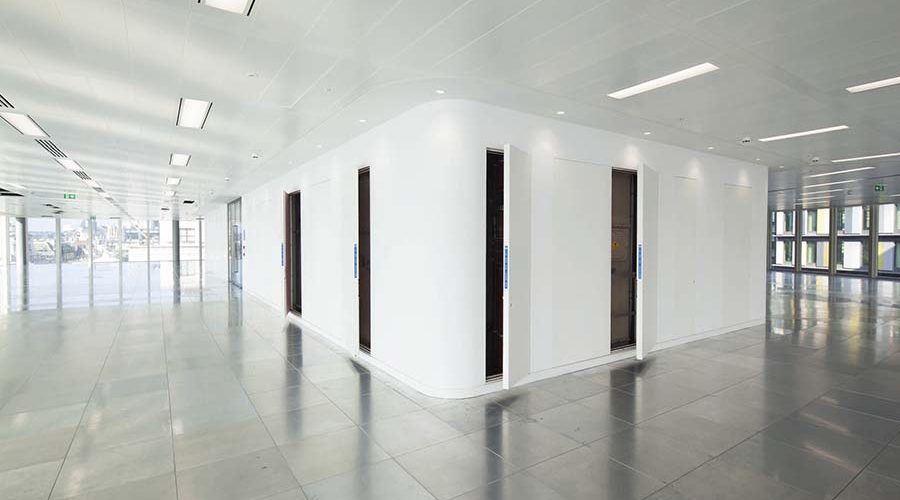The Hackitt Report revealed major concerns regarding the quality assurance of fire doors and the issues surrounding the transparency of information and the availability of audit trails with regard to these types of building components.
Profab Access
Here, Austin Stone, Technical Director at Profab Access, explores the importance of specifying riser doors that have been bi-directionally fire tested, to not only provide the highest standards of safety and compliance with current Building Regulations, but to successfully future-proof public sector buildings for years to come.
Following the release of Dame Judith Hackitt’s Independent Review of Building Regulations and Fire Safety, the issues regarding fire doors and their consistency of fire-resistance performance was, and remains, a significant concern for the industry.
The report, along with subsequent amendments to Building Regulations Approved Document B (Fire Safety), prompted significant changes to the adequate testing of fire doors, particularly with regard to the way in which these building components are manufactured, tested, installed and maintained.
Focusing on the specification and fire safety of riser doors, in particular, the sufficient fire testing of these products is paramount to ensuring the successful prevention of the spread of fire to other parts of the building via the riser shaft. Whilst timber riser doors were traditionally popular among architects and specifiers, concealed steel riser doors offer superior fire performance, whilst also offering a range of enhanced aesthetics and security benefits.
Throughout the specification process, professionals should look to utilise steel riser doors that have been fire tested to BS EN 1634-1:2014+A1:2018 (as outlined in Approved Document B Volume 2) and BS 476 Part 22. The doors should also comply with BS 476-31.1 for smoke tests, BS 8214 for the installation for fire doorsets and BS 9999:2017 for the code of practice for fire safety in the design, management and use of buildings.
However, if the industry is to drive a cultural shift in the specification of these types of passive fire safety products, architects should look to specify riser doors that have been bi-directionally tested, superseding current industry requirements.
As the riser door is physically tested in both directions, it offers the highest levels of fire safety as professionals can be confident the riser door will withstand exposure to fire and smoke from both directions for the allotted time period. This adequately prevents the spread of fire throughout a multi-storey building as the opportunity for the fire to enter the riser shaft through a riser door located in a corridor and exit through another riser door in a different area or floor of the building is entirely eliminated because both sides of the door have been successfully tested.
Professionals here should look to specify riser doors that have been fire tested by a certified third party, providing a clear audit trail of test evidence that confirms compliance with all relevant regulations by demonstrating the integrity of the riser door for the specified duration. This includes the maintenance of the riser door’s frame, limitation of the spread of fire and the transmission of radiant heat.
For many architects, the configuration of double or triple riser doors in a single unit is a popular choice due to the style of aesthetics they offer over individual riser doors that are spaced at specific intervals. Professionals should here look to work with a manufacturer that offers bi-directional fire testing across a whole suite of configurations and complementary riser door products, successfully meeting the visual requirements of each individual project, without having to compromise on the fire safety of these elements.
Whilst bi-directional fire testing isn’t a current industry requirement, this proficient approach to fire safety also future-proofs the building as the architect has gone above and beyond the current specification to meet the requirements and regulations of the future.
This step-change in the specification of riser doors must be implemented from the very initial stages and, in order to be successful, professionals should choose riser doors that are supported by a wide range of BIM and CAD files, along with comprehensive fire test certifications. This will aid the specification process and streamline the initial design stages, whilst also providing a clear audit trail of evidence and subsequent due diligence, supporting Dame Hackitt’s ‘golden thread’ of true transparency and accountability.
The test certifications play a vital role in helping architects facilitate the ‘golden thread’ of information, which seeks to extend fire safety best practice beyond fire professionals into wider society, successfully communicating key information about a building and the components utilised throughout its construction.
As Dame Hackitt encourages the industry not to wait for legal changes to start the process of behavioural change with regard to fire safety within commercial and residential buildings, professionals within the public sector can continue to drive this shift change through the specification of bi-directionally fire tested riser doors.









